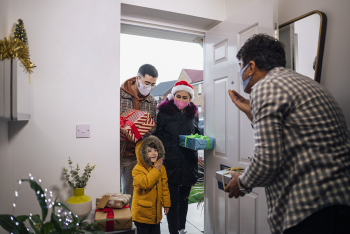A Very COVID Christmas: How to Celebrate Safely
Read More
COVID-19 is rapidly spreading throughout the U.S. and has been dominating both the news and social media conversations. Phrases like “self-quarantine,” “social distancing” and “flattening the curve” are being used by public health officials to describe what steps should be taken to stop the spread and reduce the impact of COVID-19.
You might have questions about what these phrases mean—and how they apply to you? Here are some answers to these common questions.
On a near-daily basis now, concerts, festivals and even entire sports leagues are being canceled or postponed, oftentimes with the only explanation being “due to COVID-19.”
The underlying reason behind canceling these events is so that people can practice social distancing, which is as simple as it sounds — keeping a safe distance (6 feet) from other individuals outside of the home. In large gatherings, this is nearly impossible. These methods include working from home, virtual schooling and changing business meetings to phone calls or video conferences. Some people may be allowed to work if they remain without symptoms.
Individuals who have been exposed to COVID-19 are at risk of contracting the infection and should self-quarantine for 14 days to reduce the risk of potentially spreading the virus. This two-week period gives ample time to develop symptoms of the virus or assure that you cannot give it to someone else. Some people may be allowed to work if they remain without symptoms.
Self-quarantining consists of staying within your home for this two-week timeframe with minimal—if not zero—contact with others. The CDC is a great source of specific instructions.
If you are self-quarantining with others in the home, they should take measures to protect themselves if they will be within 6 feet of you. These measures include wearing a face mask as well as protective gloves and washing their hands sufficiently after being in close contact.
If the two-week period has ended and an individual has not developed any symptoms, they should talk to their doctor to determine if it is safe for them to return to their regular day-to-day activities.
The phrase “flattening the curve” refers to using best practices in an attempt to slow the rate of spread of COVID-19. This ensures that medical facilities are not overwhelmed.
If a large group of people in a specific area were to contract the infection within a timespan of a few days, medical resources including hospital beds, and medical personnel could be overwhelmed and be unable to care for all who are sick. A surge such as the one above is portrayed on a graph as a tall narrow curve.
If the same number of patients came to the hospital for treatment but were instead spread out across a month or two, the graph would then take on a shape of a short, much flatter curve. This “flattening of the curve” ensures that hospitals and medical centers are treating patients with COVID-19 in a more manageable, more spread out basis.

While the duration of the pandemic may be longer in this scenario, it doesn't risk overwhelming the health care system as a whole, and in turn, puts the population at a much lower risk of death due to being unable to get treatment for the infection.
The best approach to avoiding this viral infection is to follow basic prevention measures. That is, reducing your risk of getting the infection in the first place.
This may sound hard, but there are steps that you can take to put not only yourself, but also those around you, in a much safer position.
Wash your hands frequently during this pandemic. Washing your hands for 20 seconds with warm water and soap helps to kill the virus should your hands come in contact with it.
Because the disease is caused by a virus, it is also important to not share food or drinks, and to practice social distancing — staying at least 6 feet away from others — if you have to go outside of your home. If you begin to feel sick, take your temperature and call your doctor.

A Very COVID Christmas: How to Celebrate Safely
Read More
After more than two years of masks, social distancing and travel restrictions, this winter is likely...
Read More
Coughing is one of the most common symptoms of COVID-19, and for some people, a lingering cough can...
Read More
The material set forth in this site in no way seeks to diagnose or treat illness or to serve as a substitute for professional medical care. Please speak with your health care provider if you have a health concern or if you are considering adopting any exercise program or dietary guidelines. For permission to reprint any portion of this website or to be removed from a notification list, please contact us at (856) 537-6772